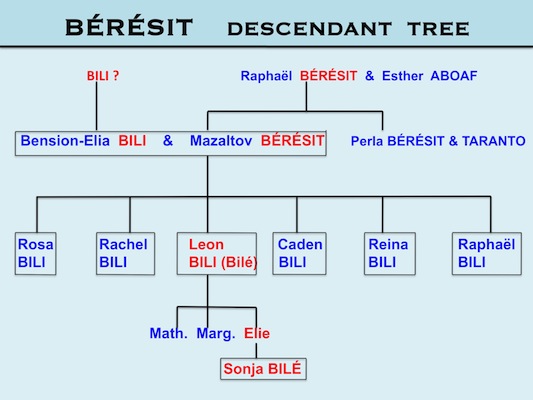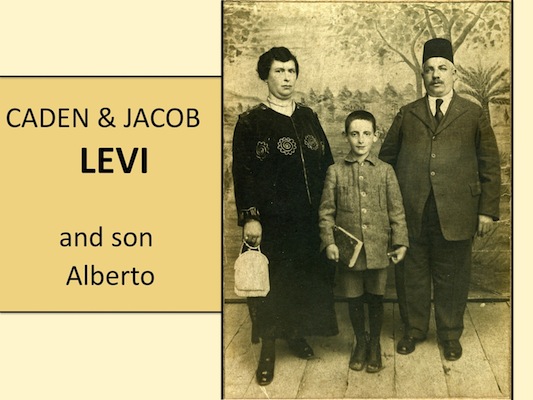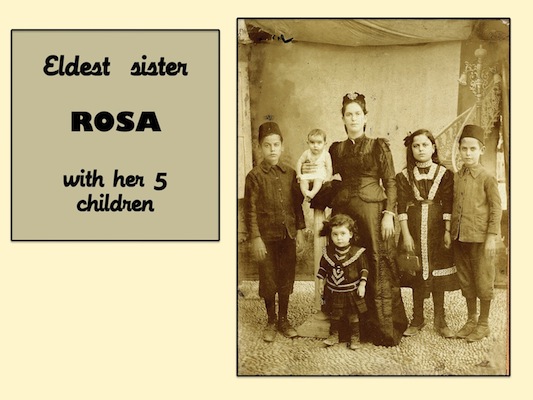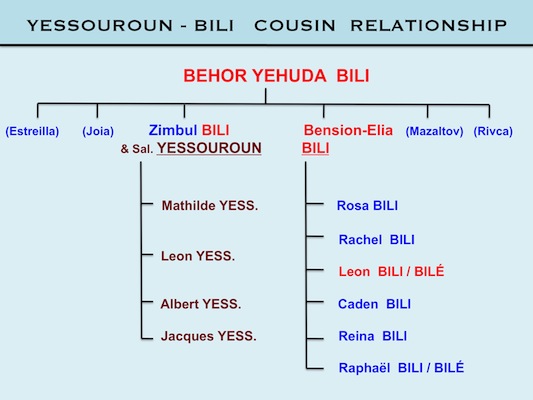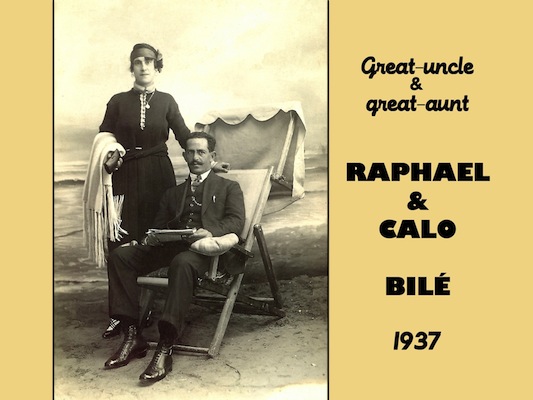Conférence donnée par Sonja Vansteenkiste-Bilé à l’occasion du 32ème Congrès international de généalogie juive du 15 au 18 juillet 2012 à Paris à l’hôtel Marriott, sous l’égide de l’International Association of Jewish Genealogical Societies (IAJGS).
Doesn’t this rather belong to the world of the romantic fairy-tale? It is so improbable one can only dream of. Yet, I was so lucky to find such a precious treasure when discovering a key document in my parental home back in 2008. It was issued by the Spanish Embassy to Belgium in 1919 and stated that my paternal grandfather Leon Bilé, whom I have never known, descended from the Jews of Spain. For that reason he was entitled to legal protection by the Spanish Embassy.
There I was at the age of 54, totally ignorant of my roots. This document was a complete riddle to me. It depicted my granddad as a descendant of Spanish Jews. All I knew was he had arrived from Turkey and spoke French. “Sephardic” was a word, a notion, which to my shame, I had never heard of. My family had never talked about granddad’s origins and questions concerning him or his brother, my great-uncle Raphael, were never answered. My grandfather died at very young age in 1927, leaving behind my Belgian non-Jewish grandmother with three young children. Great-uncle Raphael and his Jewish wife supported them very well and helped where possible. However, disaster struck again when great-uncle Raphael and his wife were deported and killed during WWII. To me, granddad had never been more than a picture of a man dressed in the uniform of the local fire brigade.
As you can imagine, this document geared up my curiosity. I was determined to track down the story of my ancestors. I only didn’t know how or where to start ?
The most obvious way was the Internet, of course. I found huge amounts of general and historical information on numerous websites, but finding the whereabouts of my own family, though, seemed further away than ever. My surname is a rare one amongst Sephardic names. I quickly figured out I would never succeed in tracing my family history this way.
Yet, driven by tenacity, I wrote an e-mail to one of the webmasters with the very few and basic data I knew. One of these was the island of Rhodes that had popped up a few times in long-forgotten family conversations. The recipient of my e-mail happened to be Dr Jef Malka, also speaker at this conference. He forwarded my request to a friend who has been involved in Sephardic genealogy for many years and, also has family links with Rhodes …
Mentioning this seemingly unimportant and definitely ambiguous fact would in the end prove the key to my first success.
Beyond my wildest dreams I received the same day a mail from Leon Taranto in Washington, addressing me as “Dear cousin Sonja”. His great-grandmother and mine had been sisters.
The needle in the haystack was found !
Leon Taranto said our common great-great grandparents were called Bérési and that my great-grandparents were Bension-Elia Bili and Mazaltov Béresi. To my very surprise they hadn’t had 2 but 6 children. Next to my granddad Leon and his brother Raphael there had also been 4 sisters and I got the names of 3 of their husbands as well. Of 2 of the sisters, family tree also showed some 5 generations of descendants.
It isn’t difficult to understand that I was over the moon !
You probably ask yourselves how this can possibly be achieved by writing only one e-mail, more or less sent at random ?
I think, inquisitiveness and perseverance are the key words, but as important is not to overlook the smallest, even the most trivial piece of information. In my case mentioning ‘Rhodes’ in my first message had done the trick.
I immediately drummed up my Belgian first cousins. Only 4 of the 6 grandchildren of granddad Leon are still alive. Each arrived with old shoeboxes full of some very old pictures that our parents had left us. Going through the pictures more questions than answers arose. Who were those people who sometimes had left a message written at the back ? One was from the Jacob Levi family from Rhodes. Granddad’s sister Caden had moved to Rhodes with their widowed mother and had married Jacob Levi. Another one showed a lady with 5 children. The back read “to Mr Bili”, undoubtedly referring to my granddad. Yet, the text below was written in enigmatic characters. Judeo-Spanish, we rightly assumed. It reads : “when you receive this picture, you surely will recognize us; your dear sister Rosa”.
This most agreeable reunion also brought back small pieces of childhood memories. Completely irrelevant on their own, but put together with the newly acquired facts, they started to make sense at last. The very patchy picture we had of our granddad started to take shape.
So far so good. Our family had grown to 6 branches down to our great-grandparents and, my relatives hadn’t only emigrated to Belgium, but to Rhodes, the USA and probably to South-America as well.
To get in touch with our American cousins I organized an extended Skype video conference. On each side of the Ocean there were some 12 to 14 cousins around the table. It was amazing to talk to the grandchildren of granddad’s sister Rosa. They told us their parents had always known about the 2 brothers in Belgium. Unfortunately, all communication ended at the outbreak of WWII. We knew why: because of what had happened to the 2 brothers.
You may already have guessed why all 6 of the Bili children emigrated from Smyrna or present-day Izmir. It perfectly reflects the living conditions of the Jewish people in the Ottoman Empire at the turn of the 20th century. Poverty, growing anti-Semitism and conscription imposed by the Turks drove them away to seek a better life. However, out of this context new questions arose. For how long had the Bili family lived in Izmir before they all emigrated? So what about the paternal Bili line, then?
Now cousin Leon referred me to the renowned professional genealogist, Rabbi Dr Dov Cohen from Israel, who’s specialized in the Jews from Izmir.
My cousins and I decided to order a paid research with Dov. Going back that far down in history definitely requires some professional help. One must take in consideration that all registers, records and documents of that period are written in old Hebrew characters. Only a few people are able to decipher them nowadays. Without doubt, Dov Cohen is a genius in that subject.
From the 1845 and 1895 Smyrna censuses Dov provided me, I learned the following:
– Firstly, our Bili family tree goes back in Izmir up to 1750, with Yehuda Bili the most remote ancestor.
– Secondly, the censuses show they paid no or low taxes
– and that my great-grandfather Bension-Elia had been a “saquero” or a sack maker.
If one paid low taxes this may indicate low income, which kind of matches with the profession of sack maker. Considering the historical context of that period and knowing that all of his 6 children had emigrated, we assumed poverty must have been the very reason why they had all left Turkey.
On a document of the Izmir Jewish Council of 1837, however, Dov Cohen found the signature of my great-great-great-grandfather Raphael Bili. I suppose the members of the Council did not belong to the poorest of the community, yet he too was exempt from paying taxes. We don’t know Raphael’s profession but he must have had a higher position. Next to poverty, special services to the community or even to the Ottoman authorities can explain why one didn’t have to pay taxes.
Now having the family tree up to 1750 is another milestone on my spectacular journey.
For the moment, going still further back in history has come to an end. But I can’t complain, can I ?
However, my curiosity had more and more turned into an irreversible passion to know more, so I turned my attention to another front.
As there is never a lack of unanswered questions, I decided to tackle the more recent history, this time closer to home.
Why had my granddad and his brother decided to move to Belgium, whereas their sisters headed for America or Rhodes? What had been their motives ? Even putting everyone’s stories together, we weren’t able to figure that out. Still too many pieces of the puzzle were lacking.
The official marriage certificate of my grandparents from the town hall of the Brussels suburb where they married in 1910 opened unexpected doors. On this certificate I discovered the name of a cousin to my grandfather who had been the witness for the groom. Particularly his unfamiliar name caught my eye. We had never heard of granddad’s cousin Albert Yessouroun. Why had our parents never mentioned this name? As Albert Yessouroun had been the official witness to the wedding he must have lived in Belgium as well. Both must have had a close-knit relationship. Had he also come from Izmir, I asked myself ?
I turned to Mr Moïse Rahmani, Head of the European Sephardic Community, who lives in Brussels. He didn’t know any Yessouroun himself but left me a very useful tip on how to proceed my quest. He said all foreigners coming to and living in our country have to be registered and all have a file at the department of “Le Police des étrangers”, The Alien’s Police department. Most of these files are kept at the Royal Archives in Brussels. The head officer of this department was so kind to track down the file numbers for the people I was interested in. The only thing to do now was to consult the files in the Archives’s reading room. I really had no clue of what to expect.
I ended up with some 300 pictures of all the documents in the files to take home and study carefully. Who says hidden treasures don’t exist but in fairy tales ?.. Well, I had just found a second one in only one year. !!
The intense study of the documents took me a while. You really have to read them word for word, sometimes again and again, as the language isn’t always clear. Moreover, most of the documents are handwritten and, in my case, mostly in French, which was the administrative language at that time in Belgium. Not an easy job, I can assure you, but it turned out to be a great leap forward.
A common feature of these files is that every move or event, civil, commercial or judicial is recorded until the person has obtained Belgian citizenship or until he leaves the country again or until he dies before becoming a Belgian citizen.
Let’s first have a look at granddad’s file. Next to each and every address he had lived at, there was evidence of his marriage and the birth of his children. Also added were his request and the procedure to obtain the Belgian nationality. I was happily surprised to read testimonies of several authorities that confirmed his excellent behaviour and his wish to fully integrate in his new country.
All of this information enabled me to broaden the picture of his life. The most important document to me, though, was an interrogation by the security services, at the end of WWI, in 1918. Both my grandparents, their, till then only 2 children and my great-uncle, who was still unmarried, had been arrested because they were, and I quote : “enemy subjects”, due to their Turkish nationality. My Belgian grandmother and the children, all born in Belgium, were of Turkish nationality too because of her marriage to a Turkish citizen.
It felt as if through the words of the interview my granddad “was telling me himself”, the story of his life. He had worked at the shop of a Mr Pontremolli in Izmir from his 13th till his 21st year of age. In 1903 he left Izmir to join his first cousin Leon Yessouroun in Paris. 5 years later he decided to join Leon Yessouroun’s brother, Albert Yessouroun, in Belgium.
To give their surname a Frenchy touch granddad Leon and his brother Raphael had slightly modified it. Bili turned into Bilé, altogether with the French acute accent on the e ! This was quite a common practice amongst Jewish immigrants to Europe. It expresses their desire for quick integration by adopting the looks and a name like any modern westerner. It also gave them the opportunity to shy away from the misery which, in their minds, their Jewishness had engendered. This practice was uncommon to their American sisters, as they had settled in existing Jewish settlements where no change of surname was needed at all.
From the interview I also learned he had been employed as a market stallholder in textiles and haberdasheries by his cousin Albert Yessouroun. This explains why the latter was a witness at his wedding !
There had definitely been close family and business relationships between granddad Leon Bilé and his cousin Albert Yessouroun. For about 3 years they had been working at the Brussels markets in wintertime and moved to Blankenberge for about 4 months in summertime, my hometown on the Belgian coast. As a seaside resort the markets attract lots of tourist customers in the summer.
Not only tourists, I’d say, as only one year later he met a local girl who would become my grandmother. Legend has it it was love at first sight and the next year they were married. Also Albert Yessouroun got married to his fiancée who had come over from Izmir. Both couples got their first child in 1910, and a second one in 1912. We have found pictures of my aunts as a baby or little girls, but to my utter surprise there are none with the Yessourouns, or with their children.
How could that be ? What kind of a mystery was I dealing with ? Their lives had been so closely intertwined and yet I couldn’t find any trace of the Yessourouns in our shoeboxes.
Again the files of the Aliens Police solved the mystery. I was totally gobsmacked when I suddenly found the original 1924 Blankenberge school report of a Joseph Yessouroun, a 12-year-old boy who had been staying at my grandparents’ house. It turned out he was the son of Jacques Yessouroun, younger brother to Albert and Leon. Jacques was staying in Brazil to run his business. But his wife didn’t acclimate to the Brazilian weather that well. So she decided to go living with their son Joseph at the home of their Belgian cousins, the Bilé family now and again. At that time my aunts were 11 and 13 years old. Why had they never spoken of their cousin Joseph Yessouroun ? He had stayed with them for at least a full school year ? I went through our pictures again but couldn’t find one showing an adult nor a Yessouroun child.
Determined to find a way to unravel the truth, I tried to trace Joseph’s only son Robert. He would be able to tell me everything about his father, I presumed. I found Robert Yessouroun when one website introduced him as a Genevan-Brussels author. We visited him in Geneva where he lives, and, to my utter disbelief, Robert was even more ignorant of his past than I was. He was completely in the dark about his father’s past and was convinced he had no paternal family at all. He was much surprised to learn from a complete stranger, who claimed to be his 3rd cousin, that his granddad Jacques had had 2 more brothers and one sister. I was able to give him the details of their descendants, his Yessouroun cousins. My mystery still stayed unsolved, though.
Help came from Laurence Abensur-Hazan, a professional genealogist from Paris and this morning the speaker just before me in this room.
She has published an article of mine about my research experiences in her Jewish genealogical review Etsi and we have become close friends. From a document in the Paris archives Laurence learnt that Albert Yessouroun’s son Salomon was born in my hometown Blankenberge in 1910. I had no knowledge of this and it wasn’t mentioned in the Belgian Yessouroun files. I immediately asked the Registry Office for a copy of this birth certificate that had virtually been lying right on my doorstep all those years. Salomon’s Paris file also revealed, he and many of his cousins visited my grandparents in Blankenberge.
This must certainly have been a lively place as so many relatives visited it and yet, no one of us had ever heard of the Yessouroun name. Mystery still not solved.
The only plausible explanation I can come up with is the rarity of this name in Belgium. Yessouroun is so unfamiliar that it could have been a liability and one of the many causes of extreme anxiousness during the war for my family. My 3 eldest cousins remember well the tensions in their families during and till late after the war. They couldn’t understand exactly why, but in their child’s mind it had something to do with an immense fear for the Germans. This resulted in hiding and even destroying many pictures and documents. They weren’t allowed to ask questions or to tell anyone about it, so they were kept in the dark and repressed their thoughts when growing older.
Today I can put 2 and 2 together. Our granddad had died a natural death 13 years before the war. He had denied his Jewish beliefs and raised his children without any religion or Jewish traditions. During the war not that many people remembered my family’s Jewishness in our little seaside town. His brother, my great-uncle Raphael, however, lived with his Jewish wife in the Jewish community in Antwerp. They had no children of their own, but adored their nieces and nephew. After the death of my grandfather, they were always there to help.
They kept good relationships, which in the beginning of the 1940ies was becoming rather dangerous. Still, uncle Raphael kept writing letters to his brother’s family in Blankenberge. The last letter, a very desperate one, is dated 5 days before their deportation in October 1943. It was sent through regular post, which was extremely dangerous to do. This letter has never been destroyed, though. It was kept hidden very well until my cousin found it when clearing her parents’ house.
This letter is the so-called third treasure in the attic. Uncle Raphael described that they had been ordered to be ready in a few days to be brought to an unknown place. He added, and I quote : “even our Turkish nationality can’t save us any longer from the Germans. Please do not write to us again, as we don’t know where we’re going and even if we’ll stay alive”
These prophetic words still haunt me today. They are the very reason why I decided to investigate the horrible fate of great-uncle Raphael. Moreover, I have this ambiguous feeling that if my own grandfather had not died before the war, I would most probably not be talking to you right now. In a way he gave me my life by dying young himself. Also my great-aunt from Rhodes was deported and killed which I am going to tell you more about in a few minutes. All in all 2 out of the 6 children who had hoped for a better life through emigration ended up in this horrible terror.
As a family member I was able to obtain from the International Tracing Service copies of all the documents recovered from the concentration camps my great-uncle had stayed in and finally died at. This Service was set up in the nineties, which explains why my family had never had a clear view of what had really happened to him. I discovered great-uncle Raphael had lived a whole year longer than was believed. After 6 months of hard labour in the Buchenwald concentration camp, he was transported to a small satellite slave labour camp in the little village of Rehmdsorf near Leipzig in former Eastern Germany. I contacted the local historian who seemed to be in charge of the remains of Camp Wille and the small memorial and we made arrangements to visit him. The small camp was only established in June 1944 and lasted till April 1945. Nevertheless, about 5000 people perished, mainly Jews, making this little camp one with the highest death rate in Germany.
My husband and I were shocked when seeing the 2 remaining original barracks in such a dilapidated state, nearly falling apart in an overgrown field. The prisoners with their bare hands, blood and sweat had built them in the freezing winter of 1944. The 84-year-old local historian has dedicated the last 40 years of his life to preserve the memory of this camp, tracked down some of the few survivors and had a memorial erected. This he has done with hardly any financial support, not from the German governmental authorities, nor from the German Jewish authorities.
We decided to engage ourselves and try to help Mr Czoßek as much as possible. As a result of our efforts he was given the prestigious “European Citizens Award” by the European Parliament last summer. He received a Certificate of Commendation from the American Obermayer Foundation last January as well as a donation of € 2000 from a German Company as a tribute to his amazing volunteer work. Last but not least, there are plans to restore the stone barracks. I cannot think of a better way to pay homage to my great-uncle Raphael and all the other victims.
At this point it felt right to go and see Izmir, the grounds of my forefathers. I’m the last one bearing the Bilé family surname but the first one to return. Together with our friend Laurence and some more Izmir descendants I finally set foot in Izmir last year some one 100 years after my family had left.
After this rollercoaster genealogical journey I assure you this was quite an extraordinary experience.
Laurence introduced me to many of her acquaintances within the local Jewish Community. This enabled me to experience and get a small taste of my family’s past. We visited the synagogue where my great- grandparents married about 140 years ago; I even tracked down the very street they had lived in, as well as the place within the Bazaar area where my grandfather and great-grandfather had earned their living.
I think, ladies and gentlemen, it needs no explanation to say this was a wonderful, sometimes moving trip, although I must confess I had not anticipated it that way.
Genealogy is a long and winding road. I had still not found track of the whereabouts of the sixth sibling of my granddad, his sister Rachel Bili. I only knew she had emigrated to South-America. Fortunately, I have the original mourning card of my grandfather’s death which mentions her husband’s surname as Buchuk.
Simply googling her name produced a picture of her tombstone in the Lima Jewish cemetery in Peru. A Buchuk descendant who lives in Lima but not related to my family, though, got me the death certificate of my great-aunt from the Lima Registry Office. I have also written to the chief Rabbi of Lima but he hasn’t answered me so far. Only the future will tell if I have arrived at a dead end. Yet, I’m not that easily defeated.
Three months ago I visited Rhodes to find back the original house where my great-grandmother went living with her daughter Caden Levi Bili in the beginning of the 20th century. Sitting in the eastern corner of the walled medieval city the Juderia of Rhodes hasn’t changed that much over the years. My aunt Caden and her husband, as well as all the remaining Jewish people, had been taken by the Germans and died in Auschwitz. Their son Alberto and daughter Selma had left Rhodes before the war but at that point I hadn’t found any descendants anywhere. The CEMLA-website shows passengers’ lists for the people who arrived by ship in Buenos Ayres. I learned that Alberto left Rhodes in 1935 as a married man and arrived in Buenos Ayres on 5th November. I hadn’t been able to trace him so far as I didn’t know his wife’s maiden name for sure, and his surname Levi is, contrary to mine, not that uncommon in the Jewish world …! So I tried my luck at the town hall of the city of Rhodes to obtain copies of some civil records from the Registry Office. To my surprise they were rather cooperative and gave me a copy of Albert’s marriage certificate free of charge ! It said Alberto Levi married Stella Bega on 15th October 1935. They must have left Rhodes in a hurry because they arrived in Argentina only 4 weeks after the wedding. Back home I posted a message on the magnificent website of the Jewish museum of Rhodes. Believe it or not, but the very next day I got an email from Alberto’s grandson who now lives in Costa Rica. A few hours after I had posted my message he had googled the names of both his grandparents because his son is seeking information for a school ancestry project. The first hit that popped onto his screen was my note. He didn’t have any information on his Rhodesli paternal grandfather’s side, but he filled me in on his own family’s story and said his sister lives in Dijon, France. Since that day in May we have exchanged numerous emails, pictures and have Skyped one another regularly. Next year my husband and I will attend his son’s Bar Mitzvah in Costa Rica.
Through my personal story, ladies and gentlemen, I’ve been trying to tell you there’s always something you can find no matter how inexperienced you may be. Is it by sheer luck or coincidence that I have been able to gather all of these fascinating discoveries? I know for sure that a healthy dose of curiosity and tenacity will lead to surprising results in the end. Only a few documents at hand can already provide a wealth of information. They should be scrutinized as the most futile fact may put you on a wonderful journey in time and space. A journey you’ll certainly never have expected but which will bring you the most amazing discoveries.
What it will feel like for you I can’t estimate but to me it has absolutely enriched my life and the way I view my identity, and for sure, it has opened my eyes a lot wider to the world.
Last but not least I have a granddad now who’s no longer but a picture.
Thank you for your attention.
Transcription d’une conférence










